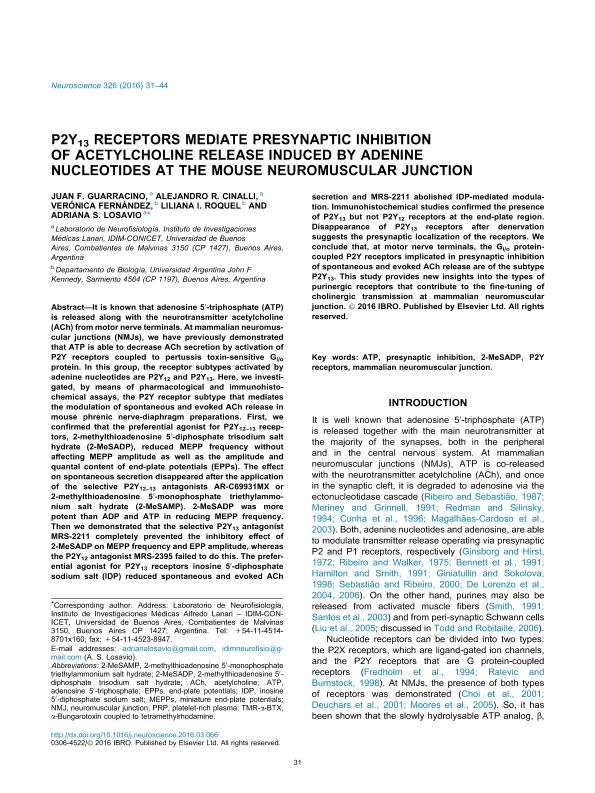Artículo
P2Y 13 receptors mediate presynaptic inhibition of acetylcholine release induced by adenine nucleotides at the mouse neuromuscular junction
Guarracino, Juan Francisco ; Cinalli, Alejandro Raúl
; Cinalli, Alejandro Raúl ; Fernández, Verónica; Roquel, LIliana; Losavio, Adriana Silvia
; Fernández, Verónica; Roquel, LIliana; Losavio, Adriana Silvia
 ; Cinalli, Alejandro Raúl
; Cinalli, Alejandro Raúl ; Fernández, Verónica; Roquel, LIliana; Losavio, Adriana Silvia
; Fernández, Verónica; Roquel, LIliana; Losavio, Adriana Silvia
Fecha de publicación:
01/07/2016
Editorial:
Pergamon-Elsevier Science Ltd
Revista:
Neuroscience
ISSN:
0306-4522
e-ISSN:
1873-7544
Idioma:
Inglés
Tipo de recurso:
Artículo publicado
Clasificación temática:
Resumen
It is known that adenosine 5′-triphosphate (ATP) is released along with the neurotransmitter acetylcholine (ACh) from motor nerve terminals. At mammalian neuromuscular junctions (NMJs), we have previously demonstrated that ATP is able to decrease ACh secretion by activation of P2Y receptors coupled to pertussis toxin-sensitive Gi/o protein. In this group, the receptor subtypes activated by adenine nucleotides are P2Y12 and P2Y13. Here, we investigated, by means of pharmacological and immunohistochemical assays, the P2Y receptor subtype that mediates the modulation of spontaneous and evoked ACh release in mouse phrenic nerve-diaphragm preparations. First, we confirmed that the preferential agonist for P2Y12–13 receptors, 2-methylthioadenosine 5′-diphosphate trisodium salt hydrate (2-MeSADP), reduced MEPP frequency without affecting MEPP amplitude as well as the amplitude and quantal content of end-plate potentials (EPPs). The effect on spontaneous secretion disappeared after the application of the selective P2Y12–13 antagonists AR-C69931MX or 2-methylthioadenosine 5′-monophosphate triethylammonium salt hydrate (2-MeSAMP). 2-MeSADP was more potent than ADP and ATP in reducing MEPP frequency. Then we demonstrated that the selective P2Y13 antagonist MRS-2211 completely prevented the inhibitory effect of 2-MeSADP on MEPP frequency and EPP amplitude, whereas the P2Y12 antagonist MRS-2395 failed to do this. The preferential agonist for P2Y13 receptors inosine 5′-diphosphate sodium salt (IDP) reduced spontaneous and evoked ACh secretion and MRS-2211 abolished IDP-mediated modulation. Immunohistochemical studies confirmed the presence of P2Y13 but not P2Y12 receptors at the end-plate region. Disappearance of P2Y13 receptors after denervation suggests the presynaptic localization of the receptors. We conclude that, at motor nerve terminals, the Gi/o protein-coupled P2Y receptors implicated in presynaptic inhibition of spontaneous and evoked ACh release are of the subtype P2Y13. This study provides new insights into the types of purinergic receptors that contribute to the fine-tuning of cholinergic transmission at mammalian neuromuscular junction.
Archivos asociados
Licencia
Identificadores
Colecciones
Articulos(IDIM)
Articulos de INST.DE INVEST.MEDICAS
Articulos de INST.DE INVEST.MEDICAS
Citación
Guarracino, Juan Francisco; Cinalli, Alejandro Raúl; Fernández, Verónica; Roquel, LIliana; Losavio, Adriana Silvia; P2Y 13 receptors mediate presynaptic inhibition of acetylcholine release induced by adenine nucleotides at the mouse neuromuscular junction; Pergamon-Elsevier Science Ltd; Neuroscience; 326; 31-6-2016; 31-44
Compartir
Altmétricas



